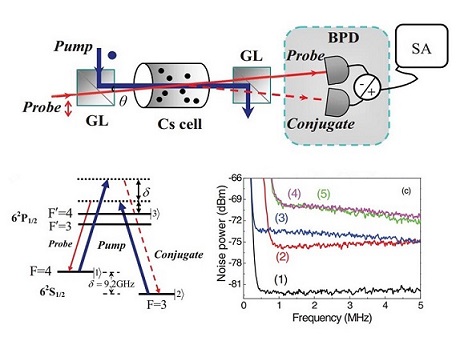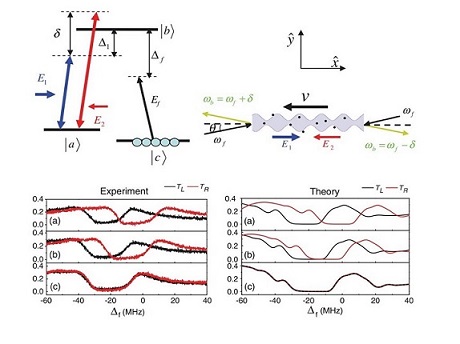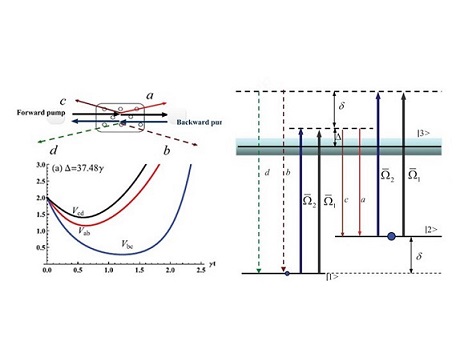Introduction:
Electromagnetically induced transparency (EIT) keeps to be an important topic of quantum optics in the past twenty years due to its wide applications in such as photon controlling, information storage and nonlinear optics. It was found that the nonlinearity in atoms can be enhanced via EIT or sub-wavelength absorption modulation (SWAM) induced by standing-wave coupling. With which method, we also found that there exists certain photonic band gaps and controllable fast (slow) light velocity in this absorption modulation atoms at the Bragg condition, and the moving photonic atoms controlled by the frequencies of coupling lights can be used as an optical diode. Furthermore, the quantum properties of generating quantum correlation beams in this EIT and SWAM-based atomic system were investigated.
Our Recent Researches:

Experimental investigation of high-frequency-difference twin beams in hot cesium atoms
Miaojun Guo, Haitao Zhou, Dan Wang, Jiangrui Gao, Junxiang Zhang, and Shiyao Zhu
Phys. Rev. A 89, 033814 (2014)
We experimentally investigate the quantum-correlated twin beams generated through stimulated nondegenerate four-wave mixing in the double-lambda atomic system. A 2.5-dB noise reduction of intensity difference with 18.4-GHz frequency difference at the cesium D1 line is observed in a Cs vapor cell. The quantitative theoretical analysis reveals the experimental difficulty in getting high quantum correlation in Cs atoms because of the large hyperfine splitting of the ground states. However, it is favorable for obtaining quantum correlation in a wide range of pump detunings and relative long lengths of vapor cells. This quantum correlation provides a potential resource for possible coherent interfaces between atomic and solid-state systems due to its wavelength at the Cs D1 line which lies well within the wavelength regime of the exciton emission from InAs quantum dots.

Optical Diode Made from a Moving Photonic Crystal
Da-Wei Wang, Hai-Tao Zhou, Miao-Jun Guo, Jun-Xiang Zhang, Jörg Evers, and Shi-Yao Zhu
Phys. Rev. Lett. 110, 093901 (2013)
Optical diodes controlling the flow of light are of principal significance for optical information processing. They transmit light from an input to an output, but not in the reverse direction. This breaking of time reversal symmetry is conventionally achieved via Faraday or nonlinear effects. For applications in a quantum network, features such as the abilities of all-optical control, on-chip integration, and single-photon operation are important. Here we propose an all-optical optical diode which requires neither magnetic fields nor strong input fields. It is based on a ‘‘moving’’ photonic crystal generated in a three-level electromagnetically induced transparency medium in which the refractive index of a weak probe is modulated by the moving periodic intensity of a strong standing coupling field with two detuned counterpropagating components. Because of the Doppler effect, the frequency range of the crystal’s band gap for the probe copropagating with the moving crystal is shifted from that for the counter-propagating probe. This mechanism is experimentally demonstrated in a room temperature Cs vapor cell.

Quadripartite entanglement from a double three-level λ-type-atom model
Dan Wang, Li-Yun Hu, Xiu-Mei Pang, Jun-Xiang Zhang, and Shi-Yao Zhu
Phys. Rev. A 88, 042314 (2013)
We present a theoretical scheme for the generation of four quantized modes in a three-level double- atomic system driven by two counterpropagating far-detuned pump beams and find the entanglement between the four modes. By using the second-order perturbation method and the phase-matching condition for the four-wave mixing processes, the effective Hamiltonian is derived, which clearly illustrates the generation of four light beams and their entanglement. The dependence of the four-mode entanglement on interaction time, pump detuning, strength of interaction force, and the ratio of Rabi frequency of two pump beams is analyzed with inseparability. The result presented here provides a method for the experimental generation of multipartite entanglement in an atomic system.
 We thank professor Zhu Shiyao of Beijing Computational Science Research Centre, vice professor Gu Yin of Peking University and proffessor Yang Xihua of Shanghai University for the helpful academic discussion and a long-term cooperation.
We thank professor Zhu Shiyao of Beijing Computational Science Research Centre, vice professor Gu Yin of Peking University and proffessor Yang Xihua of Shanghai University for the helpful academic discussion and a long-term cooperation.



